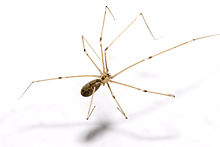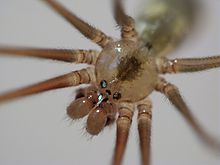Daddy long-legs spider
| Daddy long-legs spider Temporal range:
| |
|---|---|

| |
| Pholcus phalangioides | |

| |
| Close-up of a cellar spider's cephalothorax, showing two groups of three clustered eyes | |
| Scientific classification | |
| Domain: | Eukaryota |
| Kingdom: | Animalia |
| Phylum: | Arthropoda |
| Subphylum: | Chelicerata |
| Class: | Arachnida |
| Order: | Araneae |
| Infraorder: | Araneomorphae |
| Family: | Pholcidae C. L. Koch, 1850 |
| Diversity | |
| 94 genera, 1820 species | |

| |
| Estimated range of Pholcidae. | |

The Daddy-Long-Legs Spider (Pholcus phalangioides) is a spider of the family Pholcidae. Its legs are about 5 or 6 times the length of its body. It is often confused with the daddy long-legs, a member of the Opiliones, which are not true (real) spiders. P. phalangioides has the habit of shaking the web violently when disturbed. This is probably to blur the vision of a predator. Because it is often found on the ceilings of rooms, caves or cellars, it is also called cellar spider. They can easily catch and eat hairy house spiders, mosquitoes, and other insects. When food is scarce, they will prey on their own kind. Because they originally came from the tropics, these spiders do not seem to be aware of seasonal changes and breed at any time of the year.
The female holds 20 to 30 eggs in her jaws. Spiderlings are transparent with short legs and change their skin about 5 or 6 times as they grow.
Females have a body length of about 9mm, males are slightly smaller.
Crossopriza lyoni and Physocyclus globosis are spiders with a very similar appearance.
Trivia
[change | change source]- This is the only spider species described by Swiss painter and entomologist Johann Kaspar Füssli.
- Some spiders, including P. phalangioides, have the ability to completely suck out a mosquito from the tip of one of its legs, although this may take up to twelve hours.[source?]
Other websites
[change | change source]- Description and pictures Archived 2006-12-31 at the Wayback Machine
- Long description and pictures
